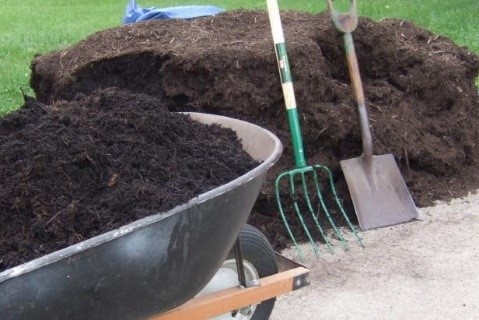Mulch can reduce weeds, keep roots cool in summer, increase soil health, help you conserve water, maintain adequate soil moisture…and it can increase the visual appeal of trees, shrubs, and flower beds. BUT only if done right.
What should you consider when choosing Mulch?
There are different textures of mulch available, ranging from very fine to coarse. Medium-textured mulch is best for most trees, shrubs, and garden beds. If there are too many fine particles in the mulch they can get packed down and block channels where water can flow to roots. Water just sits on top of the mulch and evaporates before reaching plant roots. Coarse-textured materials also cause water management problems because many are too porous to hold adequate amounts of water.
Organic mulch provides nutrient value in the form of humus as it decomposes. This increases soil health by helping soils hold onto nutrients and the decomposed organic matter feeds important soil microbes. Soil structure is also improved because humus loosens the soil structure for better air and water flow. If choosing an organic mulch make sure it is composted and treated before use so that weed seeds, insects, and disease microorganisms are killed.
Mulches are available in different colors but remember that if mulch has been spray-dyed, after a while the color will fade from sunlight or be diluted from rainfall and irrigation. You will need to replenish to keep mulch fresh looking and at beneficial levels.
How to apply your mulch to get the most benefits.
- Spread mulch under trees, shrubs, and throughout your gardens to a depth of 3-4 inches for medium-textured materials.
- Make sure you move mulch away from tree and shrub trunks. If you pile too much mulch against the trunk it can cause moisture to build up, creating an environment that is ideal for insects and diseases to fester.
- The mulched area around a tree should cover a 4-5 foot diameter area around the trunk. The larger the mulched area, the more beneficial.
The magic, and beauty, of mulch?
- Mulched soils are warmer in winter and cooler in summer than bare soils, protecting roots.
- Bare soil surfaces heat-up in summer, causing water evaporation and sometimes root desiccation and death. A layer of mulch reduces moisture loss by preventing sunlight from reaching and heating the soil. Mulch also insulates the soil moisture from evaporation on windy days.
- As mulch breaks down it adds humus to the soil, increasing organic matter to help improve the water holding capacity of soils while it slowly releases nitrogen and phosphorous into the soil.
- Mulch creates a favorable environment for earthworms and other important microorganisms that improve soil structure and fertility.
- And the best benefit of all is the beauty it adds to your yard.

